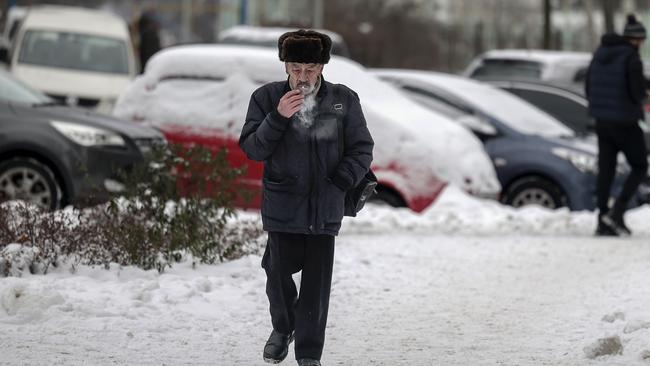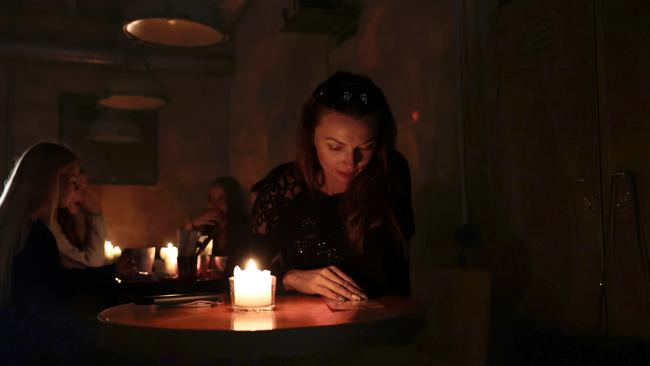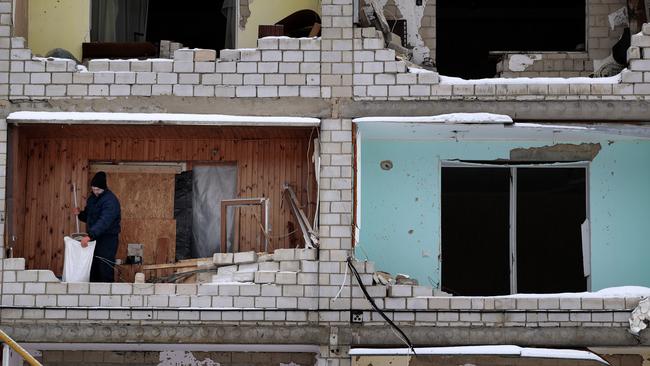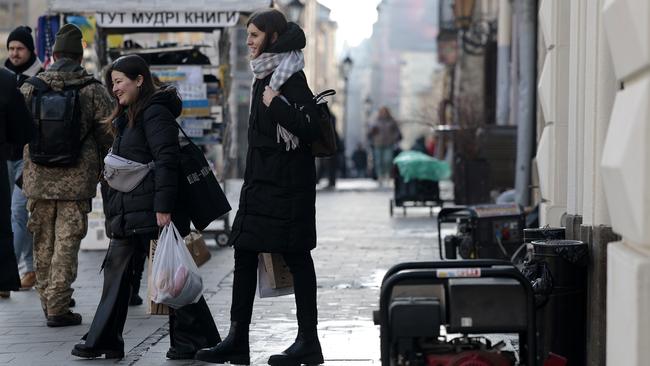Cold lays siege in Ukraine as Vladimir Putin weaponises winter
The sky is bright and cloudless above Ruska Lozova, but the enemy at this time of year is not snow – it is the frost that began last month, a frozen vice that holds the village in its grip.

The sky is bright and cloudless above Ruska Lozova, but the enemy at this time of year is not snow – it is the frost that began last month, a frozen vice that holds the village in its grip.
Before dawn this week it was minus 11C. At its coldest, the temperature in this area of northern Ukraine falls to minus 22C. “When the sun rises it’s so cold,” says Liudmila Putiatina, who lives in the village, ten miles from the Russian border. “It’s like Siberian frost. We are used to living with it, and if it’s warm inside, it’s OK.” This year, though, no one in the village is warm.
Intense fighting before the liberation of the village in May left many of its houses damaged or destroyed. Now repeated air strikes by Russian cruise missiles, the latest of them last Monday, are damaging Ukraine’s power grid. Residents of the biggest cities, including Kyiv, Odesa and nearby Kharkiv, are without regular electricity.
“This winter will be life-threatening for millions of people in Ukraine,” said Dr Hans Henri Kluge, regional director for Europe at the World Health Organisation (WHO), on a recent visit to Ukraine. “The country is facing a therma-crisis on top of a perma-crisis brought on by the war and the pandemic … Put simply, this winter will be about survival. Ten million people – a quarter of the population – are without power”.

Ukraine’s ministry of health has asked doctors to suspend all but urgent operations, because of the danger of power failures in the middle of surgery.
Nowhere is the struggle for survival more grinding and miserable than in places such as Ruska Lozova. Russian forces overran the village soon after their February invasion and used it as a base for artillery attacks on Kharkiv, which provoked shelling by Ukrainian forces. Even houses that are not wrecked by explosions have broken roofs and boarded-up windows.
“When the Ukrainian soldiers came in, we were so happy to see them,” says Putiatina, 63. “But after they came in, the Russians started firing at us. It was terrifying – for two months we had constant shelling every night.”
The village has had no electricity since February. The gas supply failed the following month. Then the house next to Putiatina’s, which was occupied by Ukrainian soldiers, was hit by 11 artillery shells. She and her family felt lucky to escape with nothing worse than a lot of broken glass, but as the winter sets in this is looking like a grave loss.
The family has a single gas cylinder in the kitchen and a wood-burning stove, fed with logs from trees hit in the bombardment, but the heat they generate escapes through the thin chipboard covering the windows and holes in the ceiling plaster.

The Ukrainian government has responded to the Russian attack on its infrastructure by establishing 4,000 “invincibility points”, equipped with generators and Wi-Fi, where citizens can go for light, water, electricity and warmth. But they are concentrated in cities. Ruska Lozova has nothing.
“Perhaps the government will help, but we don’t know when,” says Putiatina. “They talked about fixing the windows when the frost began, but nothing has happened.” Only a few hundred of the village’s former population of 5,000 remain, living a life of pre-modern hardship. They draw water from a well, which is deep enough not to freeze – but the failure of the electric pump means it must be raised by hand.
They warm water on the stove for washing clothes, which take days to dry. They live and sleep in thick layers of coats and hats. “Once every two weeks, I wash my hair,” says Putiatina’s neighbour, Irina Durihina. “In cold water.”
A mobile supermarket stops in the village twice a week, but few residents have employment or other income. “My husband and my son were both killed,” says another neighbour, Tamara Zyleima. “I’m alone and I have no salary or pension. I know it’s wartime, but I haven’t had any humanitarian aid. I got 1,200 hryvnia ($50) from the government once, and that’s it.”
Putiatina’s daughter and grandchildren remain in Kharkiv. As well as her husband, Valeriy, she looks after eight hungry dogs and 12 cats, left behind by people who have fled the village.
Cold weather can kill. Desperate families are turning to alternative heating methods, such as burning charcoal or wood, or using generators fuelled by diesel, or electric heaters. These bring health risks, including exposure to toxic substances that are harmful for children, older people and those with respiratory and cardiovascular conditions, as well as accidental burns and injuries.

The Russian government does not deny that it is deliberately striking infrastructure, which it justifies as a means of making life more difficult for the Ukrainian armed forces. But soldiers are well equipped with generators and fuel supplies and expert at managing without mains electricity. There is little doubt that the intended target is the civilian population.
Britain’s Ministry of Defence reported last week: “This is likely [to be] the first example of Russia attempting to implement the concept of a Strategic Operation for the Destruction of Critically Important Targets (SODCIT), a key component of the military doctrine it has adopted in recent years.
“Russia envisioned SODCIT as using long-range missiles to strike an enemy state’s critical national infrastructure, rather than its forces, to demoralise the population and ultimately force the state’s leaders to capitulate.”
By making Ukrainians cold and miserable, in other words, the hope is that they will turn against the war. There is no sign that this is happening, even among the people of Ruska Lozova, who have as much reason as anyone to pack it all in. “I hope that no one will die of cold,” says Putiatina. “The main thing is we are not being shelled or bombed. We’re Ukrainians, we’re going to survive.”
The Times



To join the conversation, please log in. Don't have an account? Register
Join the conversation, you are commenting as Logout